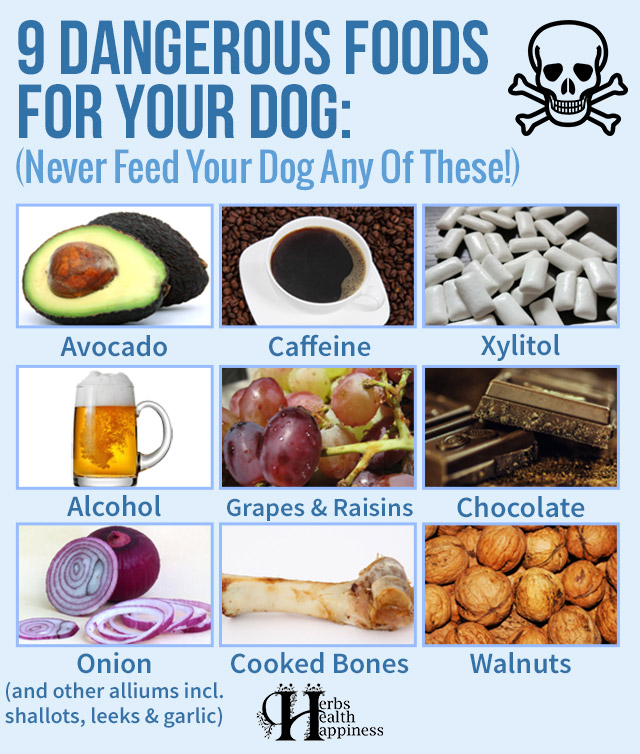
9 Dangerous Foods For Your Dog Graphic © herbsheaalthhappiness.com. Images – Pixabay (PD)
These warnings are not “urban myths” – they are real, as we will detail below.
I encourage you to print out our pic and keep it in your kitchen. Make sure your kids know never to feed these things to your dog(s) – and be sure to check labels carefully for these ingredients. Also, be sure to keep these foods out of reach of your dogs so that they cannot eat / drink them when you are not looking!
Never feed your dog any of these:
Caffeine. Dogs (and cats) are more sensitive to caffeine than us humans. The amount of caffeine found in one or two caffeine pills is reported to be potentially fatal, especially to smaller or older pets. Some of the more serious symptoms can include dangerous cardiac arrhythmia and seizures – and may begin as soon as 30 minutes after ingestion.
Xylitol. This is a sweetener that is notoriously highly toxic to dogs, even in small amounts – and potentially fatal! It often found in chewing gum, some vitamins, “low sugar” products and even some peanut butter brands! Check labels carefully! The majority of reported cases are thought to have been caused by dogs eating chewing gum, so please keep it out of their reach.
Alcohol. Very dangerous! Dogs’ livers are not able to metabolize alcohol very well, which means they can experience alcohol poisoning much more rapidly and severely than humans – and then when their typically much lower body weight than humans is also taken into consideration, the effects of a unit of alcohol are multiplied many fold.
Grapes (including raisins / sultanas) – can cause kidney failure in dogs! This effect of ingesting grapes is reported as highly variable from dog to dog, with some not experiencing ill effects but some becoming very ill after eating just a few. Some fatalities have been recorded.
Chocolate – this is not an urban myth! The theobromine in chocolate is toxic to dogs as they are unable to metabolize it and it can make them quite unwell. Symptoms manifest between 4 and 24 hours. Depending on the breed and the amount eaten, they can have vomiting, diarrhea, elevated heart rate, hyperactivity and even seizures. Fatality from chocolate poisoning is recorded as rare but possible.
Onion (and other members of the allium family, which includes leeks, shallots and garlic). Onions contain a compound called N-propyl disulphide which is poisonous to dogs! The American Kennel Club reports that 100g of onion per 20kg of dog’s weight can lead to toxic effects. In rare cases onion can be fatal to dogs. Out of curiosity I went to the kitchen, picked out a very ordinary-sized medium onion and weighed it; it was 125g. So this means that less than half an onion could be harmful to a small dog! The greatest danger in this case is possibly from leftovers containing onion, given to dogs, however I am not sure how much of N-propyl sulphide is metabolized by cooking.
Avocado. This one is generally regarded as “probably best avoided”. Avocado contains persin, a substance which has seriously harmful consequences to horses and cows. The effect is less on dogs. Persin is greater in the skin and pit of avocado than the flesh, and the level is higher in unripe avocados than in ripe ones.
Cooked bones (yes, dogs are natural carnivores, however bone becomes hardened by cooking and dangerously sharp for their insides.)
Walnuts – small amounts of fresh walnut may be ok. Black walnut – definite no.
More Foods to Avoid: Expanding the List of Dangerous Canine Consumables
While the initial list covers many common hazards, there are several other foods that can pose risks to your canine companion:
Raw or Undercooked Meat: Although in the wild, carnivores such as dogs will eat raw meat, it can contain bacteria like Salmonella or E. coli that can be harmful to dogs.
Raw eggs: These contain an enzyme that can lead to skin and coat problems.
Yeast Dough: The yeast in the dough can continue to rise in your dog’s stomach, potentially causing gas to accumulate. This can lead to dangerous bloat, also known as gastric dilatation-volvulus (GDV).
Salt: Large amounts of salt can produce excessive thirst and urination, and in severe cases, sodium ion poisoning.
Human Medications: Many common over-the-counter and prescription medications can be extremely harmful to dogs. It’s very important to keep all medicines out of your dog’s reach – especially if they are prone to chewing things or eating random items.
Macadamia Nuts: Even small amounts can cause weakness, depression, vomiting, hyperthermia, and tremors in dogs. Symptoms usually appear within 12 hours of ingestion and can last up to 48 hours.
Understanding Toxicity Levels and Symptoms
It’s important to note that the severity of a dog’s reaction to these foods can depend on various factors, including:
• The size of the dog
• The amount consumed
• The specific variety or preparation of the food
• The individual dog’s sensitivity
Common symptoms of food toxicity in dogs include:
• Vomiting
• Diarrhea
• Lethargy
• Loss of appetite
• Abdominal pain
• Excessive thirst or urination
• Rapid breathing
• Seizures or tremors
If you suspect your dog has consumed any of these dangerous foods, it’s crucial to contact your veterinarian or an emergency animal hospital immediately. Quick action can often make a significant difference in the outcome.
Creating a Dog-Safe Kitchen
To protect your furry friend from accidental ingestion of harmful foods:
• Store dangerous foods in high cabinets or in containers your dog can’t access.
• Use childproof latches on lower cabinets if necessary.
• Train your dog not to beg for food or enter the kitchen during meal preparation.
• Educate all family members and guests about which foods are off-limits for dogs.
• Dispose of food scraps securely, especially if they contain harmful ingredients.
By being vigilant about what your dog consumes and creating a safe environment, you can help ensure your canine companion stays healthy and happy.
Human Foods Regarded As SAFE For Dogs:
Here are some “human foods” that HAVE been approved for dogs:
Apples
Apricots (remove the stone!)
Asparagus
Bananas
Blueberries
Broccoli
Carrots
Green beans
Peas
Pumpkin
Raspberries
Spinach
Watermelon
References:
Battersea Dogs & Cats Home. Toxic food for dogs. https://www.battersea.org.uk/pet-advice/dog-care-advice/toxic-food-dogs
WebMD. Toxic and Dangerous Foods Your Dog Should Never Eat. https://www.webmd.com/pets/dogs/ss/slideshow-foods-your-dog-should-never-eat
The Humane Society of the United States. Plants and food that can be poisonous to pets. https://www.humanesociety.org/resources/plants-and-food-can-be-poisonous-pets
Blue Cross. Poisonous foods for dogs. https://www.bluecross.org.uk/advice/dog/foods-poisonous-to-dogs
The Kennel Club. Poisonous food for dogs. https://www.thekennelclub.org.uk/health-and-dog-care/health/health-and-care/a-z-of-health-and-care-issues/poisonous-food/
Burns Pet Nutrition. What Foods are Toxic to Dogs? https://burnspet.co.uk/nutrition-blog/10-human-foods-that-are-dangerous-to-your-pets/
★ Get My Books - 100% FREE:
😳 Tinnitus And Brain Health?
After 47 years of studies and countless brain scans done on more than 2,400 tinnitus patients, scientists at the MIT Institute found that in a shocking 96% of cases, tinnitus was actually shrinking their brain cells.
As it turns out, tinnitus and brain health are strongly linked.
Even more interesting: The reason why top army officials are not deaf after decades of hearing machine guns, bombs going off and helicopter noises…
Is because they are using something called "the wire method", a simple protocol inspired by a classified surgery on deaf people from the 1950s...
★ How To Get Rid Of Nail Fungus:
★ Does Your Salad Contain This Vegetable?
★ 20 Natural Painkillers In Your Kitchen (Video):
★ Men's Prostate Health:

2. Famous Chef Sheds 60lbs Researching New Paleo Recipes: Get The Cookbook FREE Here
3. #1 muscle that eliminates joint and back pain, anxiety and looking fat
4. 7 odd foods that KILL your abdominal fat (surprising fat-fighters)
5. The TRUTH about bread (Will surprise you!)
6. [PROOF] Reverse Diabetes with a "Pancreas Jumpstart"
7. Here's What Happens When You "Unlock Your Hip Flexors"
8. The #1 WORST food that CAUSES Faster Aging (beware -- Are you eating this?)
The #1 Muscle That Eliminates Joint And Back Pain, Anxiety And Looking Fat
By Mike Westerdal CPT
Can you guess which muscle in your body is the #1 muscle that eliminates joint and back pain, anxiety and looking fat?
This is especially important if you spend a significant amount of time sitting every day (I do, and this really affects me in a big way!)
Working this "hidden survival muscle" that most people are simply not training because no-one ever taught them how will boost your body shape, energy levels, immune system, sexual function, strength and athletic performance when unlocked.
If this "hidden" most powerful primal muscle is healthy, we are healthy.
Is it...
a) Abs
b) Chest
c) Glutes
d) Hip Flexors
Take the quiz above and see if you got the correct answer!
P.S. Make sure you check out this page to get to know the 10 simple moves that will bring vitality back into your life:
If you enjoyed this page:












